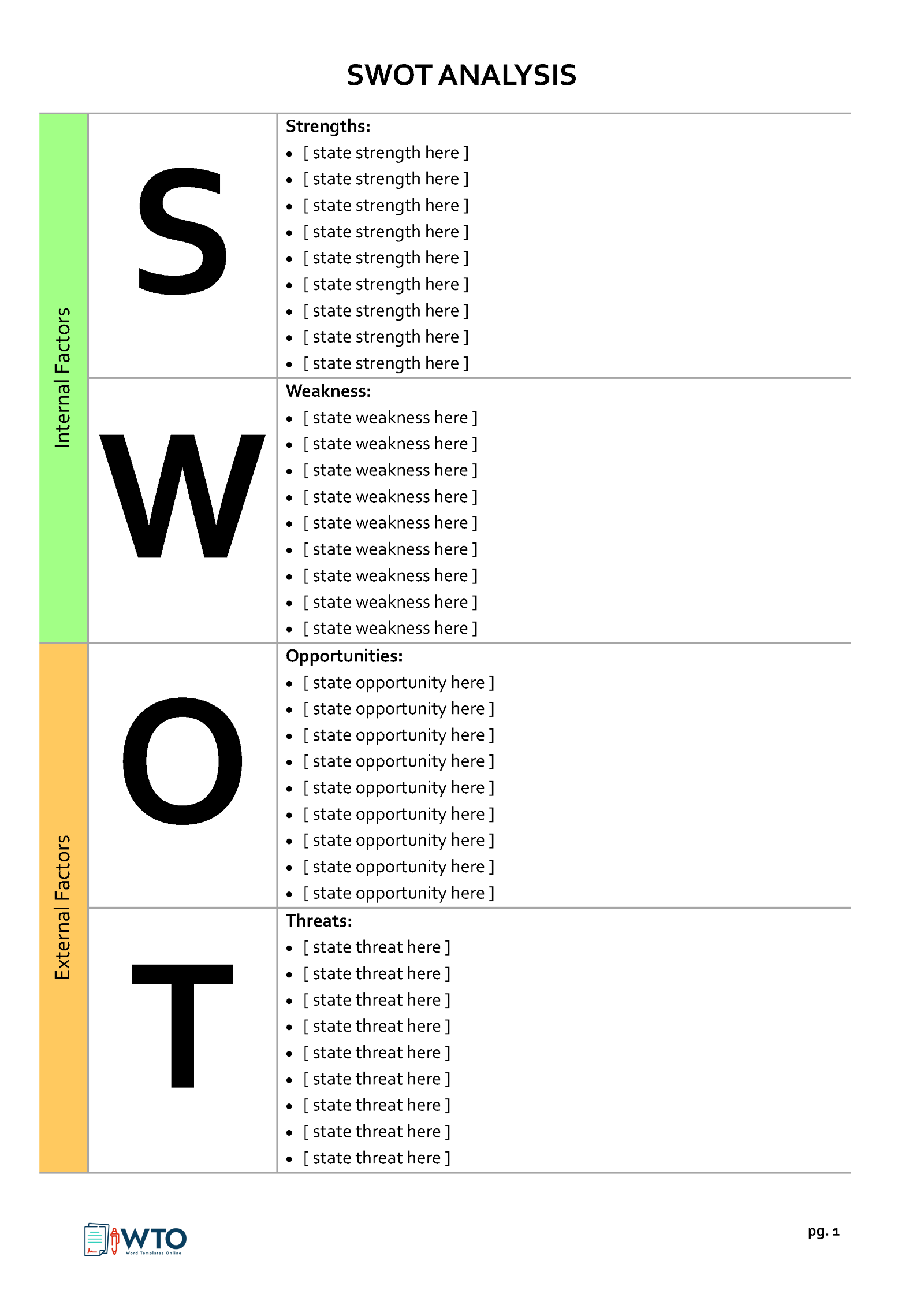It is important for companies and organizations to evaluate themselves and identify what they are doing right and areas they can improve. A SWOT analysis can be used for such an evaluation. It can be applied to the entire organization, department, or individual projects to assess their strengths, weaknesses, opportunities, and threats.
Businesses can use a template to undertake the analysis. It is predesigned to ensure every step of a SWOT analysis is undertaken. The findings of the analysis are then used for decision-making and developing growth and improvement strategies. This article is a comprehensive guide on how to use a template when performing a SWOT analysis. Also, it defines the different types of templates you can find online.
Free Templates










What is a SWOT Analysis Template?
A SWOT analysis template is a premade document with a four-quadrant matrix of the main elements of the evaluation framework – strengths, weaknesses, opportunities, and threats.
It is a visual representation of a SWOT analysis, which is a technique used to systematically evaluate the internal and external strengths, weaknesses, opportunities, and threats impacting the success of an organization. The factors under each of the four sections are enlisted and analyzed.
The template serves as a guide to undertake the entire process in a structured manner. It is beneficial in that it helps you understand how your business is positioned to handle any existing and probable challenges and threats and how it can capitalize on current and future opportunities. A SWOT analysis is, therefore, vital in strategic decision-making.
note
A template outlines the structural framework of the SWOT analysis; however, the depth and quality of the analysis depend on the information utilized and insights derived. The template helps you organize and document the analysis; however, its effectiveness depends on critical thinking and interpretation of the SWOT analysis factors.
Using a SWOT Analysis Template
The template streamlines the overall SWOT analysis process. It also helps you evaluate all the key factors that will help you determine how well or poorly your business is positioned in the current market conditions. For that reason, it is imperative to learn how to properly use the template to ensure it is beneficial to your business.
Below is a guide on how to properly utilize it:
Step 1: Find a suitable SWOT analysis template
The first step is to select a template that meets your analysis needs. There are multiple free templates online that you can download. They are predesigned to fulfill specific industry and business needs, so review multiple options before settling for one. Also, you can create printable templates on your own.
pro tip
It is advisable to use a template with enough white space to capture all the information needed to conduct a comprehensive SWOT analysis.
Step 2: Gather relevant information
Secondly, collect sufficient information to produce a proper assessment. It is advisable to have a predetermined objective in order to narrow your analysis scope. For example, you can conduct a SWOT analysis for a specific marketing strategy or company culture.
Then, collect information through:
- Surveys
- Internal assessments
- Market research
- Consultations with stakeholders
Only collect information on the internal strengths and weaknesses and external; opportunities and threats. Ensure that the information is accurate in order to conduct an effective analysis.
Step 3: Divide your template into four sections
Then, ensure that the template is subdivided into four sections to represent the four elements of a SWOT analysis and label them appropriately. This subdivision provides the basic structure you will follow to perform the analysis and help you remain focused.
Step 4: Assess and analyze each section
Next, perform the SWOT analysis using the information collected and the four sections of the template. The analysis should be systematic. Start with analyzing your strengths as a business, followed by the weaknesses, opportunities, and threats at the end.
The strengths are areas where your business excels and includes all the factors that give your business a competitive advantage. Weaknesses are the areas, departments, or strategic plans that need to be improved. These are all the factors or roadblocks that have prevented your organization from achieving expectations such as deadlines and quality.
Opportunities are captured by the external factors that present growth openings. These may include new technologies, underserved markets, potential partnerships, emerging trends, and areas of improvement or growth in your business or industry.
Threats are the risks your business faces in the current or future market conditions. These may include emerging competitors, new technology, changing customer attitudes, and regulatory changes.
Step 5: Prioritize and strategize
Afterward, you need to review all the identified factors, determine how they should be prioritized, and use this information to develop strategies. Prioritize the factors based on their significance and impact on your organization. Identify any connections and dependencies between the factors and determine the patterns. Use this information to formulate strategies that maximize the strengths and opportunities, resolve the weaknesses, and mitigate the threats.
Step 6: Take action
Lastly, you should break down the strategic plan into an implementation plan of actionable steps. In the plan, outline the tasks, timelines, and responsibilities of all the parties involved. Set clear and measurable goals that can be tracked to determine if the strategic plan is successful or not. Then, track the implementation progress by reviewing and updating it constantly to ensure any changes factored in and deviations are corrected.
These steps of using a template should be followed correctly. This way, you can conduct a SWOT analysis that helps you identify how well-equipped your business is to address challenges. Also, it gives insights on how you can strategize to grow your business into success.
Types of SWOT Analysis Templates
There are multiple free and printable templates online. They are varied to align with the different cases where they can be utilized. Below are the common types of templates you can use to conduct a SWOT analysis:
Personal SWOT analysis template
This template is a self-assessment tool to help individuals evaluate their strengths, weaknesses, opportunities, and threats. It can be utilized to evaluate your career or personal development in order to be self-aware and make informed decisions.
Business Planning SWOT analysis template
Such a template is predesigned for businesses to use whenever they want to identify the areas they are currently doing well and those they can improve or capitalize on. It is used to develop detailed strategic plans and make informed decisions on how to run an organization.
Non-profit SWOT analysis template
This type of template is tailored to suit a SWOT analysis for a non-profit organization. It is utilized to evaluate the organization’s internal strengths and weaknesses as well as external opportunities and threats to its mission. It thus helps such organizations identify how to maximize the impact of their cause and tackle existing challenges.
Conclusion
A template gives you a starting point and guides you when performing a SWOT analysis. It visually displays the four elements of such an analysis – strengths, weaknesses, opportunities, and threats. This is meant to save you time and effort from creating the SWOT matrix from scratch. Also, each section should be evaluated independently and jointly at the end to formulate strategic plans to propel the business or organization to success. You can download such pre-made templates provided above for free.




